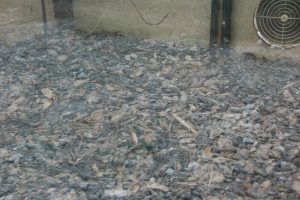Pork brings us the wonderful aromas of bacon frying, pork chops grilling and ham baking. However, the odor from a hog house is less pleasant.
A University of Missouri Extension assistant professor of agricultural systems management is researching ways to reduce that odor. Through funding from the MU College of Agriculture, Food and Natural Resources, Teng Lim is working with biofilters to reduce the odor, dust and gas emissions from typical swine operations.
Lim has evaluated small-scale biofilters at commercial hog farms and concluded that these biofilters could be scaled up to reduce emissions from larger hog operations.

“We are trying to evaluate different potential media to improve the biofilters,” Lim says. He is looking at materials within the biofilters at the MU Swine
Research Center in Columbia. Wood chips are the main type of media used in the filters, although he is also using a puffed plastic material.
The biofilters at the MU hog facility have windows to observe the materials inside and are raised off the ground to keep them away from rodents. The rooms in the research barn all have individual ventilation control systems and can be monitored over the Internet. The system uploads all the data to a server and sends a daily email with data from the previous 24 hours.
Lim says the data lets the researchers evaluate whether the pigs are comfortable and monitor temperature fluctuation, humidity, [barometric?] pressure to make sure the whole system is working.
When producers look to expand their operations or build a new barn, neighbors often have concerns about the odors. Lim says biofiltration is one of the least expensive ways to reduce odors and dust and should be part of farmers’ best management practices.
“It also shows they are concerned with taking care of the environment and their neighbors and community as well,” he says.
MU Extension structural engineers, air quality engineers, soil scientists and other specialists are working as a team to evaluate farms and offer recommendations on the best ways to mitigate odor and dust.
Lim is also conducting research on anaerobic digesters, which can help with managing waste and controlling odor while also providing a source of energy.

Manure from the facility goes through a 21-day biochemical process that produces methane gas, which can be used to fuel generators and boilers, says Brandon Harvey, a graduate assistant working with Lim.
Harvey says that a hog farm could meet its energy needs with an anaerobic digester and even earn revenue selling excess energy to the grid.
For odor mitigation alone, however, a digester is a much more expensive proposition than biofilters, he said.
“Every farm is different, so we’re trying to provide different options, viable options, sustainable options, for people to use,” Lim says. “As hog operations expand, it is critical that they be responsible for the environment and be responsible for their community and neighbors. We want to make sure they have best management practices to adopt that improve their operations and minimize conflicts in their community.”